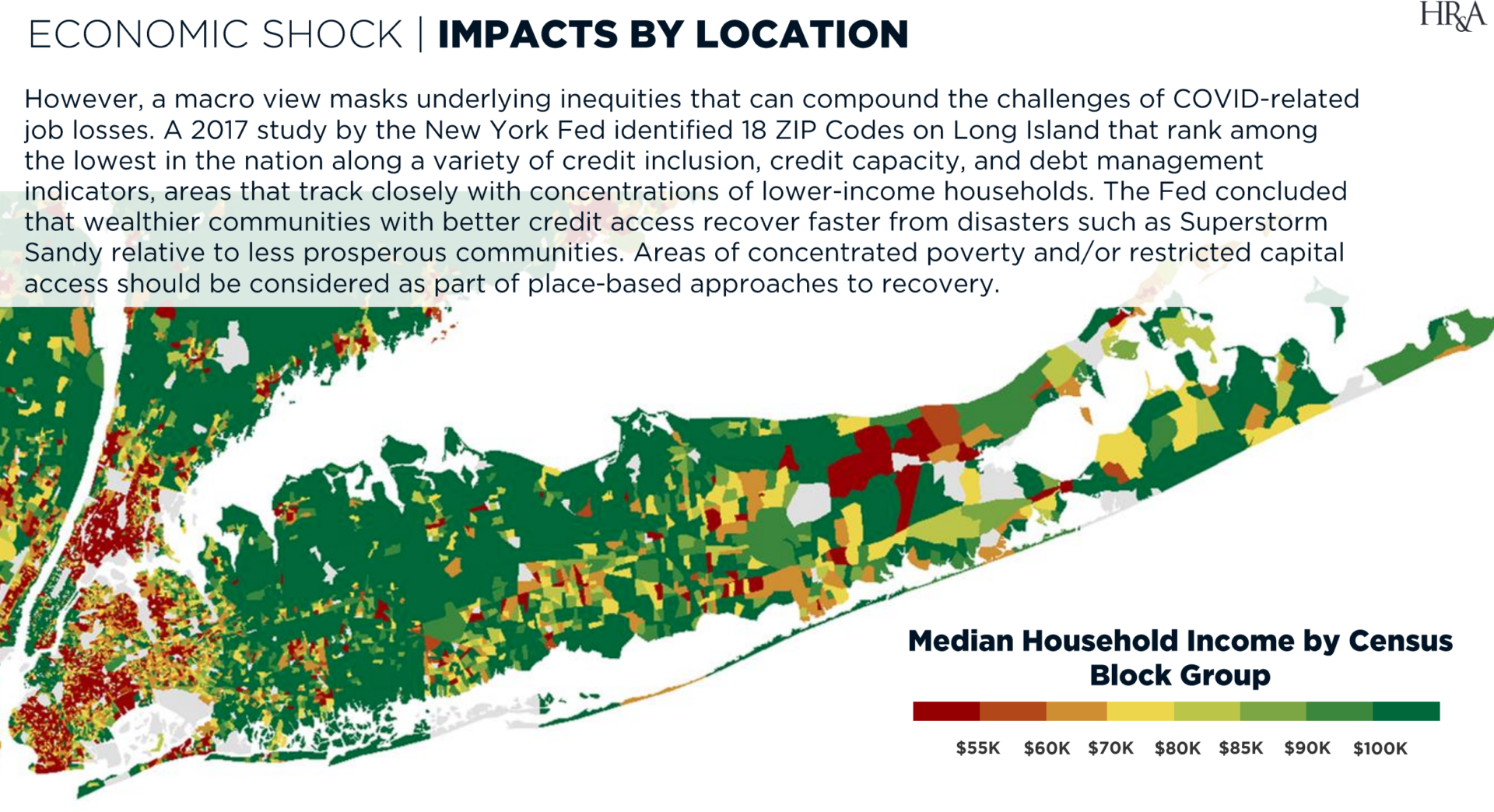Report Shows Long Island Lost Jobs at Fastest Rate Statewide During Pandemic


Long Island’s top officials called on Congress to deliver significant financial relief to Suffolk and Nassau counties reeling from the COVID-19 pandemic.
A bi-county study on the economic impacts revealed a net job loss of 220,000 to date, a disproportionate share of which were low-paying positions, workers with low levels of education and jobs held by Hispanic and Latino workers. The numbers have “fallen off a cliff,” Nassau County Executive Laura Curran said during a press conference on Thursday.
The report, developed by HR&A Advisors, a consulting firm, with support from the Nassau County IDA and Suffolk County IDA, showed that Long Island shed jobs at a faster rate than New York City and all other suburban counties in the state.
The job losses are expected to grow to a staggering 375,000, reducing earnings by as much as $21 billion and local economic activity by $61 billion.
“This pandemic has caused hundreds of thousands of Long Islanders to lose their jobs, shuttered businesses, and turned our local economy upside down,” Suffolk County Executive Steve Bellone said. “This report makes clear that federal aid from Congress is necessary if our region is going to rebound and recover from the worst economic crisis since the Great Depression.”
Sales tax revenue, which makes up about 40 percent of the budgets in both counties, is down by double-digits. Suffolk is facing an $800 million budget gap over the next two months and is facing a budget hole of up to a $1.5 billion through 2022, while Nassau expects a $749 million deficit over the next 18 months. Both counties were on track for budget surplus just before the pandemic hit.
“With the fastest rise of unemployment on record, leading to a complete fall off of economic activity, this report outlines the economic shock to our local economy and the continued pain among our businesses and minority communities—hit hardest by the pandemic in more ways than one,” Curran said. While county officials are doing what they can to revive the economy and assist those in needs, Curran said “we cannot recover from this devastating crisis alone. Washington needs to step in now with support for local governments so we can continue to provide vital services for our residents.”
Topping the list of the industries hardest hit, according to the report, was the hospitality industry, in which 82,000 jobs were lost. It saw an employment decline of two-thirds in the initial months of the crisis, Curran said during the press conference, held in front of the Hilton Long Island in Melville, on the border of Suffolk and Nassau.
The hospitality industry is also the region’s lowest-paying sector, in which Hispanic and Latino workers make up a disproportionate share of the work force, indicating, what the county executives said is disparate impacts felt among minority populations.
Even the healthcare industry took an employment hit, to the tune of 59,000. Curran said it was mainly home-healthcare aides who lost their jobs, a large portion of which are held by minorities. Retail stores shed 52,000 jobs and construction lost 37,000. Other areas hardest hit were administrative and waste services, personal services and real estate.
The report shows that 68 percent of all job losses are in sectors that pay less than the regional average annual wage of $61,600. “Wealthier communities with better credit tend to recover faster from disasters such as Superstorm Sandy,” the report said.
Recovery will come in waves, starting with the finance and insurance industry, government, and professional and technical services over a six-month period. Some industries won’t even begin the recovery period until the fourth quarter of 2021, the report projects.

The report also forecasted recovery rates and identified paths to recovery. “What do we need to do to recover? Three words. Federal disaster assistance,” Bellone said.
Federal funding outlined in the HEROES Act includes $375 billion in budgetary relief for local governments to help avert layoffs, possible tax hikes, and slashing public services. It has been passed by the House, but needs the action of Senate.
School districts are facing “massive budget cuts” because of COVID-19, Bellone added. “It’s all academic right now. It’s about to get real,” he said. Music and arts programs, sports, teaching positions are among the many items on the cutting board at the exact moment when investments need to be made in schools to make them safer.
“The federal government should have acted already to provide this assistance, that this report makes abundantly clear is absolutely necessary,” said Bellone, who called the pandemic a natural disaster. “This is the equivalent of if we got struck by a Category 5 hurricane here,” he said. The only difference is it stayed for months instead of passing in 24 hours. “The only appropriate way to respond to that is for the federal government to do what it always does when responding to natural disasters.”
Bellone said beside it being the right thing to do, it is also the smart thing for the federal government to do. “It’s in our nations interest for Long Island to get back on its feet and recover as quickly as possible.” Long Island’s federal partners are working hard, he said. “If there was ever a moment where we need them to deliver for us, it is this moment.”
In addition, the report outlined other support for residents and businesses, including federal infrastructure funds to address long-term impacts to spur job creation and transform the region and continued federal relief programs to support small businesses, encourage new businesses, and recover heavily impacted industries.
The full report is available online.









